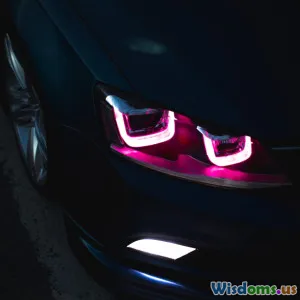
LED vs Halogen Headlights Which is Brighter
12 min read Explore the detailed comparison between LED and halogen headlights, delving into brightness, performance, efficiency, and real-world experiences to help you make an informed decision. (0 Reviews)
LED vs Halogen Headlights: Which is Brighter?
Introduction
Picture this: It’s a pitch-dark night, you're driving on a winding country road, and the illumination ahead is your only guide. Suddenly, another vehicle approaches with what seem to be ultra-bright, bluish lights, casting longer swathes of visibility than your slightly yellow, dim-fired beams. If you've noticed this—and wondered why modern headlights dazzle more than older ones—you’ve stumbled into the world of LED versus halogen headlight technology. But which is really brighter? Is switching to LEDs just a modern trend, or does it promise measurable benefits for your night drive safety and comfort?
In this comprehensive guide, we’ll pull back the curtain on the brightness debate between LED and halogen headlights, clarifying misconceptions, backing claims with real-world data, and breaking down what brightness means beyond just “more light.” Strap in as we illuminate the facts!
Understanding Headlight Basics: What Does "Brighter" Actually Mean?
Before wading into comparisons, it’s crucial to understand what “brightness” entails in the headlight context. Most consumers equate brightness with visibility, but there's more beneath the beams:
Lumens vs. Watts: Differentiating Brightness and Power
- Lumens measure the total amount of visible light emitted—a direct indication of brightness.
- Watts measure power consumption—higher watts don’t always mean higher brightness.
A typical halogen headlight consumes around 55 watts and outputs 700–1,200 lumens. In contrast, LED headlights often use just 20–30 watts to produce 1,800–4,000 lumens or more.
Example: A 2016 Ford F-150’s standard halogen low-beams put out 900 lumens per bulb, while factory-fitted LED low-beams in upper trims reach around 2,600 lumens per bulb—almost three times as much.
Color Temperature: Not Just a Cosmetic Factor
The “blue-white” light of LEDs stems from their higher color temperature, measured in Kelvins (K). Halogens usually emit a 3200K to 3500K warm white, while LEDs often range from 5000K to 6500K. This shift alters visibility: our eyes detect details better in the broad, daylight-like spectrum of LEDs, improving contrast recognition.
Halogen Headlights: The Veteran Workhorse
A Historical Staple
Since the 1970s, halogen bulbs have ruled the automotive world thanks to their simplicity, cost, and repairability. They function like traditional incandescent bulbs—a tungsten filament within a halogen gas-filled capsule radiates light when heated.
Brightness in Practice
Despite their 55-watt appetite, halogens’ brightness lags behind newer technologies. Their filament generates significant heat, causing energy loss and limiting maximum light output. The result: a familiar, golden glow, but one that can become a liability during rain or in poorly lit areas.
Real-World Insights
In a 2019 test by the Insurance Institute for Highway Safety (IIHS), standard halogen headlight beams on mid-size sedans, including the Honda Accord and Toyota Camry, illuminated only about 130–140 feet ahead, and often had issues with uneven light distribution. This means objects farther up the road remain obscured longer—critical milliseconds lost in avoiding obstacles.
Pros & Cons: The Halogen Headlight Checklist
Pros:
- Low cost ($10-$20 per bulb)
- Easy to replace
- Established, reliable technology
Cons:
- Lower brightness (700–1200 lumens)
- Shorter lifespan (500–1,000 hours)
- Higher power consumption
- Susceptible to dimming and color shift with age
LED Headlights: The Modern Illumination Revolution
Engineering Brilliance
Light Emitting Diodes (LEDs) don’t rely on heating a filament. Instead, they generate light from electronic excitation, making them significantly more energy-efficient and durable.
Brightness and Beam Focus
With advances in lens and reflector design, LEDs not only emit greater brightness but direct their powerful light more efficiently onto the road. Factory LED systems can reach 4,000 lumens for high beams, and often supply 2–3 times the usable light of halogens within legal brightness limits.
Example: The 2021 Toyota Camry equipped with factory LEDs scored "Good" in IIHS headlight tests with its high beam illuminating 200+ feet well ahead, and its low or dipped beam maintaining excellent side visibility—important for spotting pedestrians or wildlife.
Real-World Data
A 2022 Consumer Reports comparison between LED and halogen systems on popular vehicles found that LED-equipped models consistently improved low- and high-beam visibility distances, sometimes nearly doubling brightness at ground level while maintaining better control to minimize glare for oncoming drivers.
Pros & Cons: The LED Headlight Scorecard
Pros:
- Bright, focused light output (1,800–4,000 lumens)
- Significantly longer lifespan (up to 30,000 hours)
- Lower energy consumption
- Whiter, daylight-like color for improved detail recognition
Cons:
- Higher upfront cost ($50+ per bulb, significantly more for full units)
- More sensitive to heat (though most have built-in cooling)
- Complex replacements (can require complete unit swaps for factory-fitted LEDs)
Comparing Beam Patterns: Not All Brightness is Useful
Brightness by itself isn’t everything. It’s where, and how, the headlight places that light.
Importance of Beam Pattern
A dazzling headlight with unfocused scatter can reduce usable visibility and severely dazzle other drivers. Proper beam pattern ensures that high brightness translates into greater road safety—not glare.
Halogen Realities
With legacy reflectors, halogen bulbs often produce hot spots and poor spread, especially as they age. Aftermarket upgrades rarely improve this, sometimes worsening glare.
LED Precision
Modern factory LED systems use projectors or advanced reflector designs to control and spread light precisely. The result: more even roadway illumination, minimal hot spots, and less stray glare into other lanes.
Fact-Check: Aftermarket LED Bulbs in Halogen Housings
A widely-shared misconception is that simply swapping in LED bulbs into halogen housings boosts brightness. In reality, “retrofit” LED bulbs often create excessive glare due to differing light source positions, resulting in increased brightness but poor pattern and dangerous road conditions.
Quote:
“A brighter bulb in a mismatched housing isn’t a safety upgrade; it’s a visibility hazard—for you and for others.” — IIHS report, 2021
Longevity and Cost: The Value Beyond Brightness
Lifespan Comparison
- Halogen: ~500–1,000 operating hours
- LED: ~15,000–30,000 operating hours, sometimes exceeding the average vehicle lifespan
That explains why halogens require multiple replacements over years, while LEDs may never need one.
Cost Implications
Halogen bulbs are cheaper by the unit, but frequent changes increase long-term expenses. LEDs bring higher upfront investment but negligible ongoing costs—and unlock fuel savings by using less alternator power (minor, but measurable over decades).
Night Driving Safety: Brightness, Fatigue, and Perception
How Different Lights Affect Driver Fatigue
- LEDs’ white light closely matches daylight, aiding depth perception and quick identification of road hazards.
- Halogen's yellow tones may induce less visual fatigue for some, but can obscure blue and green roadway signage and camouflage certain hazards.
Glare Risks: Factoring in Others
Improperly set or installed headlights—halogen or LED—cause intense glare for oncoming traffic, reducing global safety. The American Automobile Association (AAA) notes a surge in glare-related complaints, due more to poor installations than to LED technology itself.
Stat Box:
- AAA Study (2020): Upgrading from halogen to well-designed LED lights can reduce hazardous nighttime pedestrian crashes by up to 20%, due to improved visibility margins.
Vehicle Compatibility and Regulations
Legal Limits for Headlight Brightness
Most countries and US states cap maximum output at about 3,000 lumens for a single headlight to prevent excessive glare. Factory LED systems comply, but many aftermarket bulbs marketed as “8,000 lumens!” are spot measurements, not legal, and often cause regulatory issues.
Retrofits and Warranties
Retrofitting passive LEDs into halogen housings can void warranties and expose drivers to failed safety inspections.
Pro Tip: Always choose manufacturer-approved upgrades or reputable professional installations.
Ultimate Verdict: Which is Brighter—and Better?
Summing Up with a Data-Driven Conclusion
LED headlights, by virtually all modern metrics—lumens, color temperature, beam pattern, longevity—are the undeniable winner in brightness and usable road illumination. However, “better” depends on context:
When to Choose LEDs
- If your vehicle supports factory LEDs or professionally designed upgrades
- For rural, dark, or high-speed nighttime driving
- For drivers desiring fewer replacements, safer overall visibility, and energy savings
When Halogen Might Suffice
- In older vehicles with original housings
- On a tight budget or for frequent DIY maintenance
- Where technical compatibility or regulations restrict upgrades
Quote:
“Advanced LED systems provide the clearest, most even and farthest-forward illumination ever available to everyday drivers. Safety standards are now shaped around what LED systems can achieve.” — European New Car Assessment Programme (Euro NCAP), 2022
Conclusion
If you're after brightness, clarity, efficiency, and modern performance, LED headlights outshine halogen in every measurable category—as long as they're properly designed and installed. While halogens maintain an edge for simplicity and low initial price, the overall driving—and seeing—experience leapfrogs ahead with LEDs. When safety, comfort, and cost-efficiency are factored together, investing in LED headlights isn’t merely about chasing trends. It’s about illuminating the way ahead, safeguarding life and property for many miles to come.
Are you ready to upgrade your night drives? Harness the power of the brightest technology your vehicle can safely support, and see the road ahead—clearer, longer, and better than ever.
Rate the Post
User Reviews
Other posts in Advanced Lighting Systems
Popular Posts














